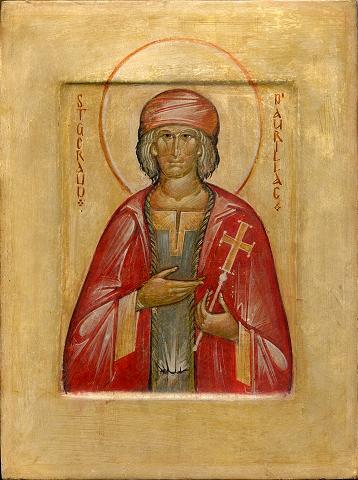
Feastday: October 13
Patron: bachelors, counts, disabled people, Upper Auvergne
Birth: 855
Death: 909
Only a little is known of the life of Saint Gerald of Aurillac, owing to the times in which he lived in the late 9th and early 10th centuries. Only one written record of his life exists and no primary sources are known.
The only known reference to him is via a book written by Odo of Cluny who lived from 879-942 and who never met Gerald. Odo however wrote that he did extensive research into Gerald's life and concluded that he was in fact, a saint.
During the course of his investigation into Gerald's life, Odo confessed that there were many reasons to doubt Gerald's sainthood. Chief among them was that Gerald was not a member of an established order of clergy, but rather lived his life as a wealthy, lay noble.
Gerald was known for being chronically ill throughout his life, possibly suffering from severe acne which left his face scarred and he became blind in his later years.
Despite these physical concerns, Gerald was regarded as a kind and merciful noble, showing mercy to convicts and kindness to the poor. His desire was to become a monk, however his noble obligations made such a transition difficult.
Motivated by faith, Gerald sought to donate his lands to the Pope, but was dissuaded by his friend, Bishop Gausbert of Rodez, who persuaded him that he could do the most good by living a pious life in private and serving the needs of his people in public. Gerald did so.
Gerald shaved a small spot on his head as well as his beard, and concealed his private devotion to the Church so that he could retain public credibility and authority. During his time, Papal authority was waning and secular forces conspired to consolidate power away from the lesser nobility.
Gerald also took a private vow of chastity. He never married and produced no children. He spent considerable time in daily, devotional prayer.
Eventually, Gerald was able to make a pilgrimage to Rome and donate some of his lands to the Church. He also established a church and a monastery on his lands, which he deliberately established in such a way as to make the monastery independent of all control except Rome's.
Gerald was a model noble, bridging the gap between religious virtue and secular authority. He showed others that it is possible to wield power and wealth while living a pious and righteous life. The skeptical Odo eventually concluded that Gerald had in fact, become a saint upon his death.
St. Gerald's feast day is October 13. He is the patron saint of bachelors, counts, and the disabled, as well as the Upper Auvergne region of France where he lived.
Gerald of Aurillac (or Saint Gerald) (c. 855 – c. 909) is a French saint of the Roman Catholic Church, also recognized by other religious denominations of Christianity.
Gerald was born into the Gallo-Roman nobility, counting Cesarius of Arles among his forebears, though the title "Count of Aurillac" was not held by his father, to whose estates he succeeded, and was assumed by him in later life. The details of his life known today come primarily from The Life of St. Gerald of Aurillac (c. 930–931) written by Odo of Cluny. Writing twenty years after the event, Abbot Odo of Cluny described how William, duke of Aquitaine, had entreated Gerald to abandon the militia regia, the feudal service performed directly to the king and pay homage to himself, "for the sake of love". Gerald resisted, having recently assumed the title of comes and doubtless preferring to owe his fealty to the more distant liege, the king at Paris.
According to Odo, Gerald suffered an illness as a child, sufficient in duration to advance his reading, and may have been disfigured by acne. In later life he was to suffer blindness. He seriously considered joining a religious order, but was persuaded against it by his friend Geusbert, Bishop of Rodez, on the grounds that with his social position he could do more good by remaining in the world as a layman. Nevertheless, secretly tonsured under his habitual cap, he consecrated his life in service to God, gave away his possessions, took a personal vow of chastity and prayed the breviary each day.
He founded a church and abbey on his estate of Aurillac, where he was buried after dying at Cezeinac/Cézerniac, name of an unclearly identified locality —possibly Cézens or Saint-Cirgues today—, on a Friday 13 October, probably in 909. His memorial feast day is October 13. The validation of his local cult by Odo of Cluny served to establish his wider veneration. Saint Gerald, considered by his Church and his followers as a great example of a celibate Christian aristocrat, is the patron saint of counts and bachelors. Because of his poor health and blindness, more emphasized in his developing cult than in Odo's Life, he is also the patron saint of the disabled, handicapped, and physically challenged. He also became the patron saint of Upper Auvergne.

